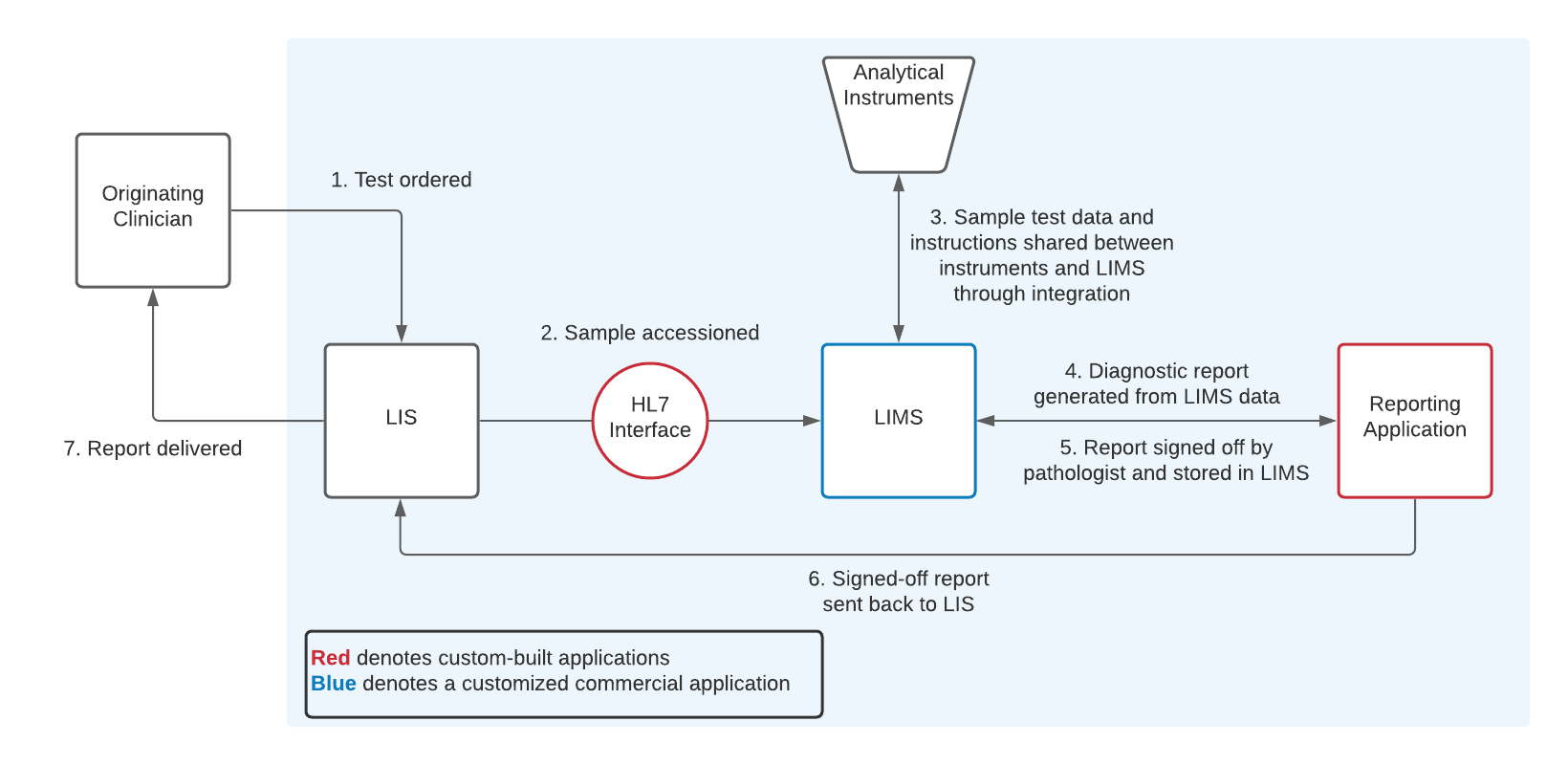A lab’s informatics system is critical for its effective operation. As we discussed in a previous post, in the early stages of a lab’s business development, a complex system might not be necessary—the lab could simply use word processing or spreadsheet software. But as labs develop new tests and ramp up throughput, a robust informatics system becomes increasingly necessary. In a highly regulated environment where reproducibility and accuracy are of utmost importance, paper isn’t a good option for tracking sensitive data.
One of our clients, a molecular pathology laboratory in a top US hospital, enlisted Semaphore’s services to help it replace a largely paper- and spreadsheet-based system with an efficient laboratory informatics solution.
Project management best practices establish clear roles & common terminology
We used an Agile+Scrum methodology to establish key roles on both software and laboratory teams and facilitate iterative software development, which allows for regular inspection of the work completed, reducing time and effort to achieve the lab’s goals. In the Scrum methodology, Product Owners are responsible for defining the product and scope, Scrum Masters centralize planning and organize the product development process, and software and quality assurance engineers perform the development tasks.
For this project, we had three teams, each responsible for areas within their domain of expertise:
- Clinical Molecular Pathology. This team included MD/PhD professional staff, alongside laboratory technologists. These team members were subject matter experts in their respective areas of laboratory medicine/pathology and genetic counseling. We also elected a single Product Owner from this team.
- Clinical Laboratory Applications. This team included pathology informaticians, hospital IT staff, project managers, system analysts, and business analysts.
- Software Engineering. Our software team included a Scrum Master, business/software analyst, quality assurance engineer, and software engineers.
During the project initiation phase, the teams learned about each other’s fields of expertise and established clear terminology. Settling on an unambiguous, common vocabulary is mandatory for a complex, multi-disciplinary project like this. It also meant we could develop requirements that made sense to everyone on the project. As the project progressed, the growing understanding and trust between the teams made it easier to optimize and improve each iteration of the software.
A robust laboratory informatics system, built with future growth in mind
Each molecular pathology lab has its own unique requirements. In this case, the lab needed an informatics solution that could integrate its current laboratory information system (LIS) with a new laboratory information management system (LIMS). We built an HL7 interface between the LIS and LIMS that first checked the validity of HL7 messages coming from the LIS. Valid test order messages resulted in the accessioning of the sample in the LIMS with all of the information required by the lab to complete the tests.
The lab also needed the LIMS to support its expanding panel of molecular diagnostic tests, so we customized it to accommodate this requirement and enable scaling. To accomplish this, we created custom workflows that were designed and optimized to model the lab’s test procedures, including sample accessioning, DNA/RNA sample enrichment and preparation, sequencing, and data analysis. We also built integrations between the LIMS and their laboratory instruments to facilitate automatic data transfer.
To support clinical reporting, we built a custom application that organizes analytical data from the LIMS and generates a draft diagnostic report for review by a pathologist. When the pathologist electronically signs off on the report, it’s sent back via HL7 to the LIS for delivery to the clinician who ordered the test.

Molecular pathology laboratory as-built informatics system flow
Streamlined processes that no longer rely on paper or spreadsheets
The new solution, with the customized LIMS and custom-built HL7 interface and reporting application, has produced a number of benefits for the lab. For instance:
- It gives the lab full control over patient report formats with fully customizable templates and automatically populated data.
- It maintains test data provenance and lets staff review the complete history of a sample.
- If the lab decides to integrate a different electronic medical record (EMR) system in the future, because it’s modern modular software, the HL7 listener and report release service are easily configurable to support any new system.
Other benefits that have resulted in a calculable return on investment for the lab include:
- A more efficient way to introduce new tests.
- Simplified, standardized results reporting across all tests.
- Improved troubleshooting and simplified root cause analysis during testing.
- A centralized interface for tracking specimens as they move through the testing workflow.
- Operational reporting, offering insights such as the true cost of testing and monitoring sample volumes.
- Optimized use of human lab resources. In particular, the lab has noticed that medical technologists spend significantly less time on clerical tasks, accessioning exceptions, and data transcription.
- Reduced time and effort spent on regulatory submissions associated with software due to comprehensive “as-built” requirements that were generated throughout the build process.
But best of all, we were able to largely eliminate the use of paper and spreadsheets in the lab, streamlining processes with software workflows and automation. That means there’s less risk of error, and staff are free to work on more complex and interesting tasks—enabling the lab to grow its capabilities and further enhance its reputation in the professional community.
Contact us if you need help upgrading your informatics system.

